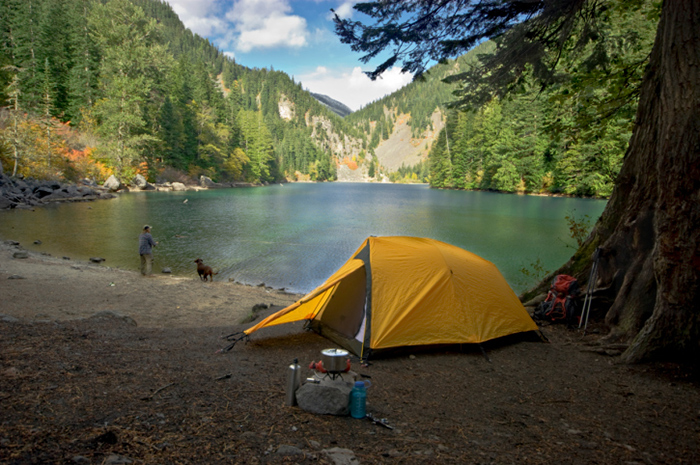
I didn’t grow up camping. My parents preferred bungalows, which admittedly are a lot more comfortable for family vacations in South African game reserves where you have to take lions, elephants, and malarial mosquitoes into account! In Canada, I’ve embraced the ethos of pitching a tent, wading in a lake, melting ‘smores in the fire, and listening to the wind blow in the surrounding forests. You’d be crazy not to. The upside of being a camping newbie is the research I had to do to figure out how to choose the best campsite, pack for a trip, and make camping as enjoyable as possible.
Here’s a simple guide for those who might find themselves in a similar situation.
Picking a Site at an Established Campground
Campgrounds with reservations may assign you a site. Free campgrounds allow you to pick your own. Come early for the best choice.
Consider how near the action you want to be. Picking a site near the restrooms, showers, and phones can make life convenient, but can also subject you to noise and foot traffic.
Sites near the facilities may be an excellent choice if you have children. You can keep an eye on them without having to accompany them to the restroom, etc. each time.
Avoid setting up directly under a tree unless shade is a major issue. Bird droppings, twigs, and leaves can drop down on your tent. Camping under a tree is dangerous in a thunderstorm or windstorm.
Picking a Backcountry campsite.
Safety is the prime consideration when picking a back country campsite. Look for your site well before sunset. Choose a site on level ground close to a water source.
Be safety-conscious. Avoid spots with indications that bears have been near. Stay away from flash flood zones, and areas prone to avalanches. A shady forest spot is ideal in the summer, but look for a natural clearing to avoid falling branches. Always choose dry ground if possible, as damp areas can breed mosquitoes. In colder weather seek a southern exposure, and keep in mind that higher land is warmer at night. When camping on a beach, be aware of the tide levels. Even if the water seems sufficiently far away, high tides can drench a good night’s sleep.
Setting Up Camp
Choose a level solid spot to pitch your tent. A forest duff, rock slab, or previous campsite is ideal. Using a previous site helps you avoid leaving an impact on the surrounding wilderness. Make sure that the surface is smooth, with no rocks or other debris which can tear your tent floor.
Most commercial tents have an attached floor. When camping on soft forest duff this may be all you need. Ground sheets can be used as an additional moisture barrier under your tent floor. Ground sheets should be a few inches smaller than your tent, so that the edges don’t poke out and collect moisture like gutters.
Pitch your tent entrance away from the wind; if you are forced to pitch on a slope, the tent entrance should be downhill to avoid rain. Drive the pegs in at a 45-degree angle with the points in the direction of the tent. Take your flashlight with you to avoid tripping over the pegs if you go out at night.
If your car is nearby, lock away food and bring fold-up chairs.
Other Safety Considerations
• Pack your food in airtight containers so that it won’t attract animals and hang it from a tree or other place away from your tent.
• Keep your first aid kit handy.
• Be aware of where you are in relation to roads, your car, or the trail.
• Wear boots when walking on rough terrain or in heavily forested areas.
• Drink adequate water, especially at high altitudes.
• Make your campfire far from your tent and put it out carefully when you leave; remember even a small spark can smolder and flame up.
• Observe campfire bans, and leave only footprints.
Easy enough right? Sure, if you’ve been doing this all your life. For first-timers, camping can be intimidating. Our terrific agency partner Great Canadian Trails organizes epic camping and hiking trips (like Newfoundland’s East Coast Trail) with a guide to choose the best spots, cook meals and even set up your tent. That’s definitely one way to do it! M ake camping comfortable, fun and safe, and you can bet it beats a bungalow.
